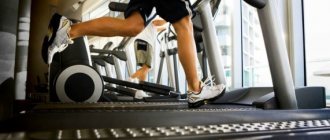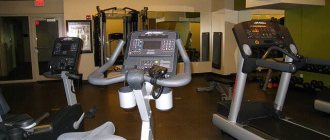If a person sets a goal to lose excess weight using running training, it is important to remember that there are rules that determine how to run correctly in order to lose weight.
During running, the human body spends a significant amount of energy. At the same time, metabolic processes are stabilized, calories are burned, the metabolic rate increases, and the functioning of the digestive organs is improved. In addition, the muscle corset is strengthened, cells are saturated with oxygen, cholesterol levels are lowered, and cardiovascular activity is improved.
Running is considered the simplest and most effective weight loss technique available to anyone. At the same time, those who are fighting the hated kilograms note that even with constant training, the weight can remain at the same level. In order for running training to achieve the desired result, it is important to follow a number of rules and conditions.
Why should you run in the morning?
If you're still unsure whether it's worth sacrificing a precious hour of sleep in favor of a morning jog, check out the benefits you can get from such workouts:
- you can get rid of excess weight in the shortest possible time;
- the heart and blood vessels will be in perfect order;
- you will become so resilient that you can easily do without an elevator;
- viruses will bypass you;
- sleep will become sound, without night awakenings and nightmares;
- you can wake up without an alarm clock;
- forget about stress and depression;
- you will make new friends and acquaintances who also want to join a healthy lifestyle.
Why should you run in the morning?
In fact, running at any time of the day is beneficial, but morning cardio has some serious benefits.
- Burning fat in the morning is much more productive, since glycogen reserves, which the body uses as an energy reserve, are minimal at this time. Therefore, at the beginning of the day, just a 20-minute run is enough to start the process of recycling fat ballast. And in the evening this may take 2-3 times longer, which makes the training ineffective.
- After a night's rest, the body requires activity, and therefore any physical activity is much easier to bear than at the end of the day.
- The compression load on the spine after waking up is insignificant, since this part of the musculoskeletal system, like the entire body, receives sufficient rest at night. Therefore, you can run safely without fear of back pain.
- In the morning, a person needs a powerful boost of energy, while in the evening it is unnecessary. However, nothing prevents you from taking a walk before bed for your own pleasure and admiring the sunset.
How long should you run in the morning?
How much time you need to run in the morning depends on several factors:
- floor,
- age,
- level of physical fitness,
- health conditions,
- build.
The best option for such a workout for beginners is 10–20 minutes at an average pace. After a week, when the body adapts to the stress, the jogging time should be gradually increased, bringing it to 40–60 minutes. The duration of running sessions at a fast pace should be no more than 20–40 minutes.
Regularity is also extremely important, so run at least 4-5 times a week. You can train every other day, or every day, and on the weekends give yourself a well-deserved rest. However, this does not mean that you can lie down on the couch for two whole days. It's better to spend your free time usefully. For example, devote a couple of hours a day to walks in the fresh air.
The choice of time for running is also important. So, in the summer, it is better to start training at 6–7 am, when the sun has not yet had time to gain strength and the air temperature is as comfortable as possible. In winter, the start time is shifted by 1–2 hours.
Jerk, more jerk, and now slow down, please.
If your main running goal is to lose weight, then your best solution is to turn to interval running. What is this? In short: alternating short intervals of fast and slow running. This “ragged” rhythm requires more calories and, as a result, burns fat more effectively. In addition, this style of exercise is more productive for increasing endurance.
Before starting training, we advise you to visit your doctor and check your health, as there may be restrictions due to the condition of the joints, excess weight, and heart disease.
If everything is in order: there is both a desire and the doctor’s permission, then you can proceed directly to training.
Special tables containing the progress of training with interval running for weight loss and designed for each level of training of the runner can help in constructing a training schedule. They can be used by both women and men.
Note: rest is slow jogging at a comfortable speed, during which breathing is restored.
1) For beginners
| Stage | Workout progress |
| Warm-up | Brisk walking – 10 minutes. |
| Interval running | Level I: 1 min. run + 2 min. rest. (Alternate for 20 minutes.) Level II: 2 minutes of running + 2 minutes of rest. (Alternate for 20 minutes.) Level III: 3 min. run + 1 min. rest. (Alternate for 20 minutes.) |
| Hitch | Gradually slower walking – 10 minutes. |
Advice for beginners: move to the next level as soon as you are ready to increase the load. Don't rush to shock your body with excessive stress. In matters of sports, it is necessary to observe the rule of gradualism.
2) For those prepared
| Stage | Workout progress |
| Warm-up | Brisk walking – 10 minutes. |
| Interval running | Level I: 2 min. run + 3 min. rest. (Alternate for 20 minutes.) Level II: 3 min. run + 2 min. rest. (Alternate for 20 minutes.) Level III: 4 min. run + 1 min. rest. (Alternate for 20 minutes.) |
| Hitch | Gradually slower walking – 15 minutes. |
3) For experienced
| Stage | Workout progress |
| Warm-up | Brisk walking – 7 minutes. |
| Interval running | Level I: 3 min. run + 2 min. rest. (Alternate for 20 minutes.) Level II: 4 min. run + 1 min. rest. (Alternate for 20 minutes.) |
| Hitch | Gradually slower walking – 15 minutes. |
You should not exhaust yourself with cardio exercises every day, this will only exhaust your body and instill in you an aversion to playing sports. If you stick to your plan, then within a couple of weeks you will notice significant changes in your volume, and after a couple of months this will be noticeable to everyone around you.
Jogging in the morning. How much should you run to lose weight?
A typical mistake of those who want to lose weight through running is to train until they are completely exhausted in order to lose as much as possible at once. This approach is not only meaningless, but also dangerous to health. Physical activity with significant weight creates a dangerous load on the organs of the cardiovascular, respiratory and musculoskeletal systems. To avoid injuries and pathologies, you should balance your strength with your own weight.
- 110 or more kilograms . Intense loads are strictly contraindicated. Running at a slow or medium pace (distance 75–100 meters) alternates with walking. The total training time is no more than 20 minutes. With each subsequent lesson, we increase this time by 5 minutes. We run every other day.
- 85–110 kilograms . Classes are held daily for 20 minutes, with constant progression. You can change the pace of running with the obligatory transition to a step.
- 60–85 kilograms . We also start running 20 minutes a day. You can cover up to 500 meters without taking a step. Speed – no more than 10 km/h. After a month of working in this mode, the duration and pace of classes increase.
- Less than 60 kilograms . The running intensity is high and constantly increasing. The duration of classes is from 30 minutes per day.
Otherwise, you won’t be able to break through the training plateau, forcing fat to burn, with such a physique.
People who are overweight are strongly advised to choose running shoes with shock-absorbing soles to reduce stress on their joints.
Contraindications and restrictions
Running training as a way to get rid of excess fat is not suitable for everyone. There are a number of reasons why you should refrain from this type of activity:
- diseases of the spine (intervertebral hernia);
- diseases of the joints of the legs, hip joint;
- disorders of the cardiovascular system
If the following factors are present, running time should be limited:
- during exacerbation of chronic diseases;
- during menstruation;
- during lactation.
Running is contraindicated for overweight people, as such stress can lead to damage to the knee joints.
How to run in the morning?
Strict adherence to running technique will help a novice athlete get involved in the training process faster and avoid injuries. Here are its main principles:
- You need to start your workout with a light 10-minute warm-up. It includes a set of simple exercises to warm up the muscles and increase the elasticity of the ligamentous-articular apparatus: walking in place with the knees raised high, Jumping Jack, lateral lunges with pelvic transfer, running with shin sweeps, etc.
- You don’t need to start actually running right away. We walk the first 50–100 meters, after which we gradually increase the pace. If serious discomfort arises during training: a tingling sensation in the side, there is not enough air, the pulse has increased greatly - we go back to walking. If the break does not help, stop training.
- While running, the body should be tilted slightly forward, and the arms should be bent at the elbows and work in unison with the legs. We land on the entire foot or heel, but in no case on the toe.
- It is very important to breathe correctly: inhale only through your nose, but you can also exhale through your mouth. In winter, this will help avoid colds. Between inhalation and exhalation you need to take 2-4 steps.
- You cannot make sudden movements or quickly change the rhythm. This can cause injury.
- Monitor your heart rate with a fitness bracelet. Normal heart rate while jogging is 120–150 beats per minute. Try not to exceed these values.
What style is best for beginners to run?
People who are just starting cardio training and want to lose weight with it can run in several styles.
- Easy cross . Its main difference from the classic one is that you can run short distances (500–800 meters) on straight terrain. Ideally, you should cover at least 2 km without stopping, but for beginners it is better to do this in stages: changing to a step every half a kilometer.
- Interval running . One of the best fat burning techniques, the essence of which is to change the speed every 100 meters:
- slow running;
- running at an average pace;
- running with maximum acceleration;
- running at an average pace;
- Slow running and further according to the described scheme.
The cycle is repeated up to 3-4 times per workout. Once your body adapts to this routine, try running in intervals of 200 meters, then 300 meters, etc.
- Classic cross (cross-country running). And this is an option for advanced people, helping to burn calories with a vengeance. Ideally, the route should run through hilly terrain with steep ascents and descents, so you can only train in this style outside the city.
The technique here is somewhat different: you need to run up the hill as quickly as possible so that the leg muscles do not have time to acidify. When descending, the legs and arms must work even more often, but only in order to shorten the so-called flight phase. In other words, you need to run from the mountain, and not fall, following the force of inertia. When lifting, keep your body straight or slightly tilt it forward. When descending, pull back a little to avoid unnecessary acceleration.
Tactical training
You can prepare for any race, and during training you can cover the entire distance without any problems. But a mass start is significantly different from individual training. There will be athletes who will take the lead from the start to take prizes, as well as beginners who, due to lack of experience, will run faster than their own capabilities from the very start and want to cling to the leader.
I advise you not to be a beginner and stick to a comfortable pace. Don't worry if after a kilometer of distance you find yourself in last positions. Maintain your pace and watch how after 3 kilometers the first runners who were trying to overtake the leader give up. At kilometer 5, you will begin to overtake 5-10 athletes every 100 meters. At the mid-distance mark, those who are more or less ready for the race will remain, and you will be able to find 50-60% of the participants behind you.
When there are 5-7 kilometers left to the finish, increase the pace by at least 5-10 seconds for every 1000 meters. This way you can beat another 10-15% of runners. For the remaining 3 km, add another 5 seconds and maintain the pace until the finish line. In the last few hundred meters to the finish, constantly accelerate, and just before the line, use your last strength. Usually at the end of the distance no one wants to fight with someone who is trying to overtake and this is a good opportunity to improve the position in the finishing protocol.
As a result of a completely simple tactic, you can count on finishing in the first 10-20% of participants, which is not bad for your first or second half-marathon experience.
Interesting fact: The Track and Field all-time organization collected the 2020 best results in half marathon running among men. We used this information to determine that the difference between the result that ranks 1st and 2022nd is only 3 minutes 6 seconds.
A good option would be to find a person whose pace is approximately equal to yours. This will allow you to support each other during the distance and periodically come forward or give up the lead to your partner.
Additional tips for new runners
We figured out how and how much to run in the morning. But there are other tricks that will help make such workouts more productive and enjoyable:
- start training no earlier than 30 minutes from the moment you wake up;
- take a shower to invigorate yourself;
- drink a glass of water or kefir so as not to run on an empty stomach, but at the same time stimulate metabolic processes (you will have a full breakfast after your workout);
- try to run on dirt roads (this will create an additional shock-absorbing effect);
- do not talk or drink water while running;
- after maximum acceleration, stop and gradually switch to slow running;
- in bad weather conditions (especially ice), cancel the workout;
- equip yourself correctly (you can read more about choosing clothes and shoes for running in this article);
- It’s more fun to run with music, but it’s better to replace a heavy smartphone with a lightweight player;
- It is better to plan your jogging route in advance so that there are fewer cars and more green spaces.
When can I expect results?
The question that worries every beginner, motivates them to get up in the morning and run towards a slim body: “How much should you run to lose weight”? With regular training and following the recommendations, the result will come approximately within the following time frame:
| Number of kilograms burned | Duration of regular training | Additional terms |
| 1 kg | 1.5 - 3 weeks | The result depends on the characteristics of the body, the intensity of training, nutrition and lifestyle. |
| 3 kg | 1 - 1.5 months | |
| 5 kg | 2 - 2.5 months | |
| 10 kg | 4 - 5 months |
Don’t forget that when you achieve results, it’s not time to start training. To maintain your new form, continue to increase your pace and enjoy the process of running.
How should a beginner runner eat?
Some more interesting and useful information. Scientists have calculated that to burn 1 kg of fat you need to run for at least 19 hours. That is, in order to lose 10 kg it will take about 6 months of daily training. This is probably not quite the result that many were hoping for.
“How much should you run in the morning to speed up this process?” - you ask. Without a balanced diet, it will take a very long time and with a high risk of gaining weight back. Therefore, it is recommended to radically reconsider your diet.
Pay special attention to breakfast, since the calories spent during training need to be quickly returned. The question arises: why did we burn them then, and wouldn’t this give additional weight gain? Not if those calories are right. First of all, a runner needs a solid energy boost, which can be obtained from slow carbohydrates (mainly cereals). Fast carbohydrates, however, are also needed, but not all of them. The ideal option for a good carbohydrate breakfast is oatmeal with berries, fruits or dried fruits.
What about proteins? Beginning track and field athletes also need a lot of them (0.6 g per 1 kg of weight). Therefore, after a run, the menu must include protein foods: boiled or scrambled eggs, omelet, cottage cheese, yogurt, etc.
How to eat throughout the day, everyone decides for themselves. You can follow the classic scheme: a hearty breakfast, a medium lunch and a light dinner. Or eat a little, but often (5-6 times a day). The main thing is to consume fewer calories than you burn (on average, 15–20%). However, with daily running exercises, their consumption increases significantly, and at the same time the appetite. Therefore, the risk of overeating naturally increases, which can easily reduce all efforts made to nothing. The natural complex for safe weight correction KiloLight .
The drugs in this series help overcome food addiction and saturate the body with truly valuable nutrients, many of which are extremely problematic to obtain from the daily diet.
In addition, KiloLight provides reliable support for connective tissue, the weakness of which against the background of rapid weight loss leads to such unpleasant consequences as varicose veins, cellulite, stretch marks on the skin, etc. And the white cinquefoil root included in this complex stimulates the functioning of the thyroid gland, the main regulator of metabolic processes in our body.
Don't know how to overcome the craving for late-night snacks? The evening preparation of the KiloLight will help you resist unnecessary temptations and set yourself up for a sound and healthy sleep, so that in the morning you will be full of strength and energy before your next workout.
You can purchase this innovative complex in pharmacies and specialized online stores.











